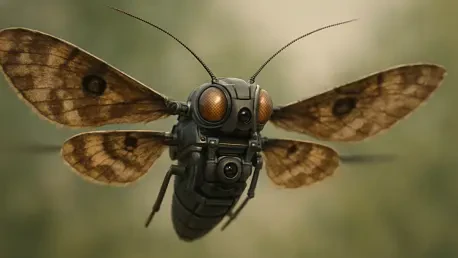What if the secret to cutting-edge drone technology isn’t hidden in lines of code, but in the delicate flutter of a moth’s wings? Picture a drone so small, so nimble, that it dances through the air like an insect, navigating complex environments without a single algorithm steering its path. At the University of Cincinnati, researchers have brought this vision to life with a moth-like drone that achieves autonomous flight without artificial intelligence. This pint-sized marvel, inspired by nature’s tiniest aviators, hints at a future where technology mirrors the elegance of the natural world, challenging everything known about unmanned aerial vehicles.
Why This Drone Breakthrough Stands Out
The significance of this innovation cannot be overstated in a world increasingly dependent on drones for tasks ranging from package delivery to disaster response. Traditional drones, especially at smaller scales, grapple with inefficiencies in power consumption and the heavy computational load of AI-driven navigation. This bio-inspired creation, however, sidesteps those hurdles by embracing simplicity, offering a glimpse into how micro-scale drones could transform industries like surveillance and environmental monitoring with minimal resources.
This project, led by Assistant Professor Sameh Eisa, isn’t just about building a better drone—it’s about rethinking the fundamentals of flight technology. By drawing from the mechanics of hovering insects, the team has crafted a solution that addresses real-world challenges, proving that nature often holds the most efficient answers. The implications stretch beyond engineering, potentially reshaping how autonomy is achieved in compact systems.
Unveiling the Moth-Like Design
At the heart of this drone lies a design that mirrors the intricate flight of moths and hummingbirds. Unlike conventional rotor-based models, this “flapper drone” features four wire-and-fabric wings that move independently, replicating the rapid flapping and subtle figure-eight patterns seen in nature. This mechanism generates lift on both upstrokes and downstrokes, ensuring remarkable agility and stability even at a miniature scale.
What sets this drone apart is its ability to operate without complex software or GPS. Instead, it relies on an extremum-seeking feedback system—a straightforward loop that adjusts wing-flap frequency in real time. Whether hovering in place or tracking a moving target like a light source, this system mimics a moth’s instinctual draw to a flame, achieving autonomy with minimal computational demand.
Lab tests further highlight its efficiency for tiny applications. Intentional wobbling during flight, a feature inspired by natural perturbations in insect movement, allows the team to evaluate and optimize performance. This adaptability makes the drone a perfect candidate for discreet tasks where size and stealth are paramount, such as covert data collection in tight spaces.
Behind the Scenes: Voices of Innovation
Inside the Modeling, Dynamics and Control Lab at the University of Cincinnati, the minds behind this project share a passion for blending biology with engineering. Assistant Professor Sameh Eisa underscores the beauty of minimalism, stating, “Nature proves that profound outcomes can stem from basic systems. This drone’s feedback loop may even reflect how insects manage with limited cognitive capacity.” His insight points to a deeper connection between technology and the natural world.
Doctoral student Ahmed Elgohary offers a hands-on perspective on the drone’s autonomy, recalling the struggle of manual operation. “Attempting to control it by hand was a nightmare, but the feedback system took over seamlessly,” he explains. This contrast emphasizes the brilliance of the design, where simplicity outshines human intervention, paving the way for effortless navigation.
Published in Physical Review E and accessible on arXiv, the team’s findings also hint at broader scientific impact. Eisa speculates that extremum-seeking feedback might be a universal trait in nature, not just a technological tool. This hypothesis could spark new inquiries in biophysics, bridging the gap between engineered solutions and evolutionary mysteries.
Real-World Potential and Practical Applications
The practical applications of this breakthrough are vast, particularly for industries seeking compact, autonomous drones. In surveillance, for instance, a device this small and unobtrusive could monitor sensitive areas without detection, offering a significant edge over bulkier alternatives. Environmental research also stands to benefit, as these drones could navigate dense forests or urban zones to collect data with minimal disturbance.
For engineers and innovators looking to build on this concept, the approach offers clear lessons. Studying natural flight mechanics, such as those of hovering insects, can inspire designs that prioritize energy efficiency over heavy hardware. Implementing basic feedback loops instead of AI-heavy systems reduces complexity, making autonomy achievable even in resource-constrained settings.
Specific use cases are already emerging as testing continues from 2025 onward. Targeting niche areas like disaster zone assessments, where small drones must operate in unpredictable conditions, could be a focus. Refining these feedback mechanisms through controlled experiments will ensure resilience against real-world challenges like wind or obstacles, broadening the scope of deployment.
Looking Ahead: Lessons from a Tiny Drone
Reflecting on this journey, the development of the moth-like drone at the University of Cincinnati marked a pivotal moment in redefining autonomous flight. The fusion of bio-inspired design with a minimalist feedback system demonstrated that complexity isn’t always the answer—sometimes, nature’s simplicity leads the way. This project not only crafted a tool but also opened a window into understanding insect behavior through an engineering lens.
Moving forward, the challenge rests in scaling these insights into broader applications. Industries and researchers are encouraged to explore how such lightweight, efficient systems could tackle pressing needs, from enhancing surveillance capabilities to aiding in climate monitoring. Collaborative efforts between engineers and biologists could further unravel the secrets of natural flight, ensuring that the legacy of this tiny winged wonder continues to inspire innovation.









